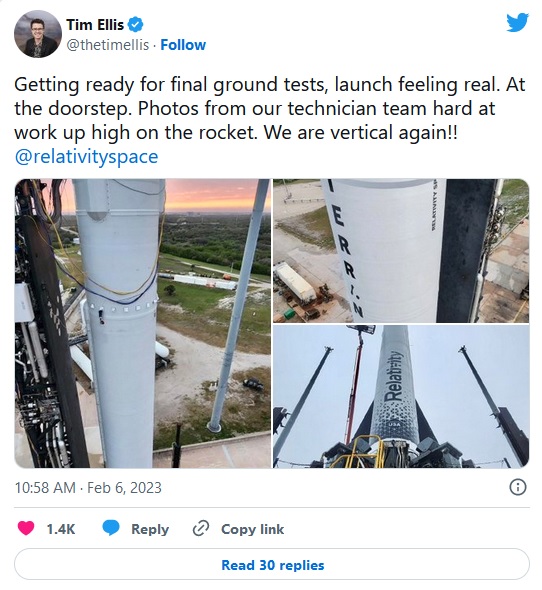Relativity Space announced on the 6th that their Terran 1 3D printed rocket had gone vertical at SLC-16 on Cape Canaveral SFS, and was undergoing final testing to ensure it's ready for its first orbital mission attempt. While no launch date has been officially announced, they're apparently very close to being ready and the last time we heard much from them they said, “The next time Terran 1 is out on the pad, it will be stacked and vertical. Upcoming milestones to track: rollout, static fire, and launch.” It seems possible they could launch before the end of February.
The ~110 foot tall Terran-1 is a said to be 85% 3D printed by mass, and they're looking to increase that to closer to 95% in following missions; in fact, it has been said that the company itself is probably best thought of as an additive manufacturing company rather than just a rocket manufacturer. As of now, they describe Terran-1 as, "the largest 3D printed object to exist and to attempt orbital flight."
I've mentioned Relativity in the past in the context of being a contender in the race for the first one-metric ton payload rocket to orbit. Another race they're a contender in is to be the first liquid methane/liquid oxygen rocket to achieve orbit. Methane-oxygen (or methalox) engines are widely considered to be The Next Big Thing in rocketry, but while a couple of the big names have methalox engines (Starship, Vulcan and New Glenn), nobody has flown one into orbit yet.
It's important to note that Relativity Space is using Terran-1 to develop a larger, more powerful, more reusable version called Terran-R. Oh, by the way: the first mission of the Terran-R is currently written in as totally private mission to Mars. In the next launch window, which will be in the last quarter of 2024. As in a couple of months less than two years from now.
In a comment to this photo from the previous Twitter post, a user noted that it was quite different to see the printer layer lines that those of us who use home-level 3D printers are used to seeing on our prints on something as high-tech as an orbital rocket. Now that I've noticed them, I see them all the time. Almost top to bottom.


Good thing they printed it using "draft mode", else they'd still be waiting for the job to finish in 2027.
ReplyDeleteIF they can do it, well and good. First one's always a crapshoot.
ReplyDeleteBeing the first gives you bragging rights, but the race is not to the swift, but to the sure. SpaceX is being very careful and wants to do it right the first time following their mantra of build/test/break/analyze/repeat. A good study in iterative processes and how they work in real life. They are being somewhat copied, indicating the most sincere form of flattery!
Everybody should go check out Stoke Space. Are they going to manage to fly an aerospike?
ReplyDeleteI still haven't watched the hour long video with Everyday Astronaut. The couple of videos with test firings I've watched make it seem they're a lot closer than anybody else I've heard of.
Delete